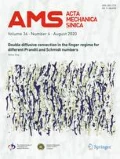Abstract
The induced airflow from passing trains, which is recognized as train wind, usually has adverse impacts on people in the surroundings, i.e., the aerodynamic forces generated by a high-speed train’s wind may act on the human body and endanger the safety of pedestrians or roadside workers. In this paper, an improved delayed detached eddy simulation (IDDES) method is used to study train wind. The effects of the affiliated components and train length on train wind are analyzed. The results indicate that the affiliated components and train length have no effect on train wind in the area in front of the leading nose. In the downstream and wake regions, the longitudinal train wind becomes stronger as the length of the train increases, while the transverse train wind is not affected. The presence of affiliated components strengthens the train wind in the near field of the train because of strong flow solid interactions but has limited effects on train wind in the far field.


























Similar content being viewed by others
References
Baker, C.J., Sterling, M., Figura-Hardy, G., et al.: The effect of train slipstreams on passengers and trackside workers. In: Proceedings of the 7th World Congress on Railway Research, Monteral, 2006
Pope, C.W.: Effective Management of Risk from Slipstream Effects at Trackside and Platforms. Rail Safety and Standards Board–T425 Report, 2007
Gilbert, T., Baker, C.J., Quinn, A.: Gusts caused by high-speed trains in confined spaces and tunnels. J. Wind Eng. Ind. Aerodyn. 121, 39–48 (2013)
Baker, C.: The flow around high speed trains. J. Wind Eng. Ind. Aerodyn. 98, 277–298 (2010)
Baker, C.J., Quinn, A., Sima, M., et al.: Full-scale measurement and analysis of train slipstreams and wakes. Part 1: Ensemble averages. Proceedings of the Institution of Mechanical Engineers, Part F: Journal of Rail and Rapid Transit 228, 451–467 (2014)
Yao, S., Sun, Z.X., Guo, D.L., et al.: Numerical studies on wake characteristics of high-speed trains. Acta Mech. Sin. 29, 811–822 (2013)
Muld, T.W.: Slipstream and flow structures in the near wake of high-speed trains [Ph. D. Thesis] Stockholm: KTH Aeronautical and Vehicle Engineering, 2012
Liao, S., Mosier, P., Kennedy, W., et al.: The aerodynamic effects of high-speed trains on people and property at stations in the Northeast Corridor. US Department of Transportation Federal Railroad Administration, 1999
Lei, B., Liu, Y.-G.: Computational analysis on human body aerodynamic force due to train induced air flow. J. China Railw. Soc. 21, 20–23 (1999)
Huang, Y., Wu, W., Zhang, H., et al.: Discrete vortex method and its engineering application. J. Basic Sci. Eng. 8, 4 (2000)
Tong, B., Xia, N., Li, Q.: Dicrete-vortex method in external flow problems. Adv. Mech. 15, 318–328 (1985)
Li, R., Zhao, J., Zhang, S., et al.: Influence of the aerodynamic force to human body near high-speed trains. China Railw. Sci. 28, 22 (2007)
Hemida, H., Baker, C.: The calculation of train slipstreams using large-eddy simulation techniques. In: 9th World Congress on Railway Research, Lille, 22–26 May, 2011
Hemida, H.N.: Large-eddy simulation of the flow around simplified high-speed trains under side wind conditions. [Ph. D. Thesis] Chalmers University of Technology, Goteborg (2006)
Lee, H.: Assessment of potential aerodynamic effects on personnel and equipment in proximity to high-speed train operations. US Department of Transportation Federal Railroad Administration, 1999
Peng, L.-M., Liu, C., Shi, C.-H., et al.: Characteristics of the train wind and analysis of personnel safety in the high-speed railway station. J. Zhengzhou Univ. (Eng. Sci.) 34, 99–102 (2013)
Star CCM+ User Guide version 9.04, CD-adapco Corporation
Author information
Authors and Affiliations
Corresponding author
Rights and permissions
About this article
Cite this article
Guo, D., Shang, K., Zhang, Y. et al. Influences of affiliated components and train length on the train wind. Acta Mech. Sin. 32, 191–205 (2016). https://doi.org/10.1007/s10409-015-0553-z
Received:
Revised:
Accepted:
Published:
Issue Date:
DOI: https://doi.org/10.1007/s10409-015-0553-z




